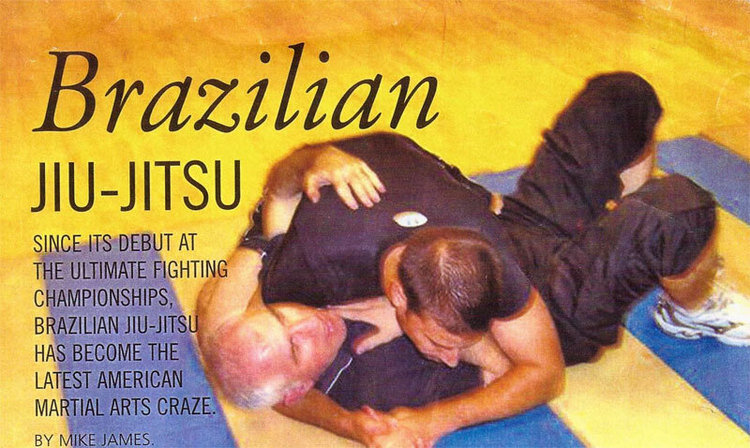Brazilian Jiu-Jitsu
/Since its debut at the ultimate fighting championships, Brazilian Jiu-Jitsu has become the latest American Martial arts craze.
By Mike James
It is 2pm in the nation's capital, Washington DC. While George Bush is in the White House grappling with the world's problems, three blocks away two fit young men are on the floor exchanging wristlocks, arm bars and choke holds. This is not the scene of another street mugging.
These two white-collar warriors are in a fitness center practicing Brazilian Jiu Jitsu, the "newest" and some claim, the most effective martial art in the world. Brazilian Jiu Jitsu has been widely popular in Brazil since the 1950s, but has only recently come under the spotlight in the U.S.A.
Baby boomers here were brought up with a media saturated by rock em sock em movies, where good guy cowboys (like Roy Rogers in white hats) dispensed summary justice to evil "black hat" bad guys with a well-placed punch to the jaw!
In the 70s and 80s our world view expanded. Asian martial artists like Bruce Lee dispensed high-flying kicks and acrobatic moves with stunning effect.
In the mid-1990s The Ultimate Fighting Championships brought together martial artists, boxers, wrestlers and experts from all fighting disciplines into an eight-walled cage called the Octagon. We would find out "once and for all" which was the most effective fighting system.
At the end of the pay-per-view contest, it wasn't the high-flying martial artists, punchy pugilist or 117-kilogram wrist locking wrestler who won the day. Emerging victorious was a 76-kilogram Brazilian, performing an art called Brazilian Jiu-Jitsu (BJJ).
Royce Gracie dominated the first few Ultimate Fighting Championships against street fighters, wrestlers, boxers and a variety of martial arts styles. The methods Gracie used are based on ground fighting techniques, which rely on body position, leverage and control.
In America there are now many schools dedicated to teaching this martial arts system, and health clubs and fitness centers are starting to 'include Brazilian Jiu-Jitsu for its' self-defense and fitness benefits.
IDEAL FOR WOMEN
Brazilian Jiu Jitsu isn't just another gimmick to lure the trendy health club member searching for the eternal body beautiful, or the aspiring martial artist trying to be the next Royce Gracie. For women in particular, the techniques, which use leverage and body position rather than brute strength, make it very effective for escaping from an attack by a stronger, more powerful person.
Tracey Patterson a petite 54 kilogram 26 year old, who had previously studied kick-boxing, has been learning BJJ for a year. She feels that it has given her greater confidence. "Brazilian Jiu Jitsu teaches you to counter moves while you are on your back and to use various escape techniques to either incapacitate or escape from an attacker," she says.
THE TECHNIQUES
BJJ is one of the few martial arts systems that teach techniques from a ground-based position. As most physical confrontations or assaults occur on the ground, it is here where its techniques can be particularly useful.
SOME OF THE BASIC POSITIONS
The guard: In this situation a person has been pushed to the ground and is on his back with his attacker on top. By wrapping his legs around the aggressors' hips and using leverage to control their upper body, the victim can use his opponent's superior strength against him leaving him winded and open for chokeholds and submissions.
Side control: (see photograph) By extending his legs to the side and bearing his weight down on the opponent underneath, a victim can control his attacker's movement by employing a head and arm lock to smother, submit and strangle him.
The mount: Here the victim maneuvers himself into a position where he is sitting on his attacker's chest with one leg either side of his torso. This effectively immobilizes the opponent underneath allowing the victim to strike, choke or to employ a wrist or joint lock for submission.
The back mount: From behind, the victim locks his legs around his attacker's hips and upper thighs. This enables him to use a rear choke hold and essentially immobilize a physically stronger person by restricting their hip and leg movement.
"The various techniques are based on strategy not strength,” explains Luis Alvarado who has been studying BJJ for over 10 years and teaching for five. "It is like playing chess, but you are using your body as the game piece." BJJ teaches a "flow" of movements intended to get a victim into a position where he has an advantage over an attacker. "The concept of flow is very important and the moves become instinctive through constant practice and repetition," says Alvarado. "This way a person will react to a threatening situation immediately without having to think about complex maneuvers.”
Will Brazilian Jiu Jitsu make its way out of the Octagon and follow Boxacise, Spinning and Pilates as the new "must do" class at health clubs? With personal safety becoming an increasingly important issue in today's society, self-defense disciplines will become more and more popular among people of all ages, male and female.
For information about BJJ clubs in Australia go to bjj.com.au.
